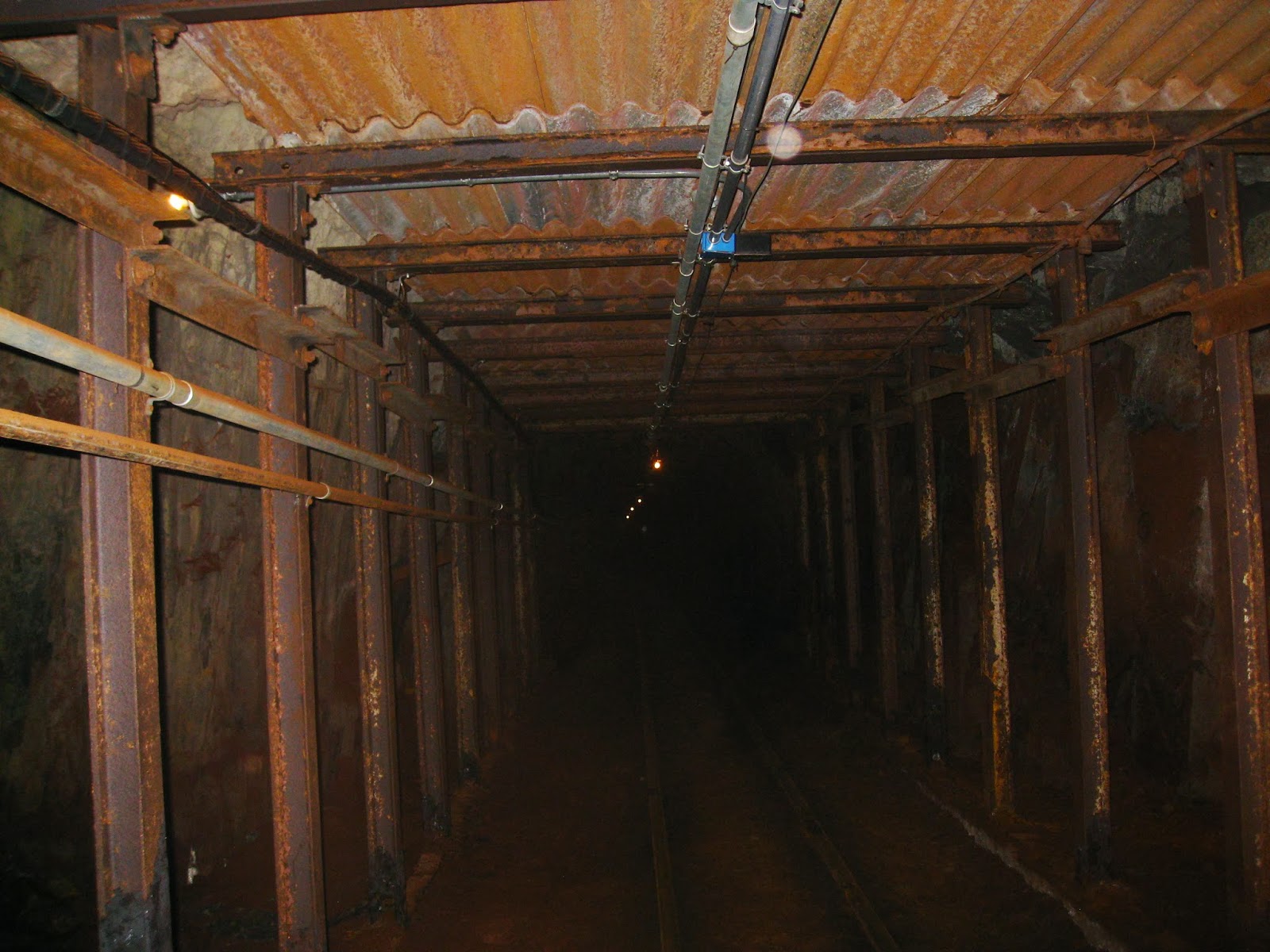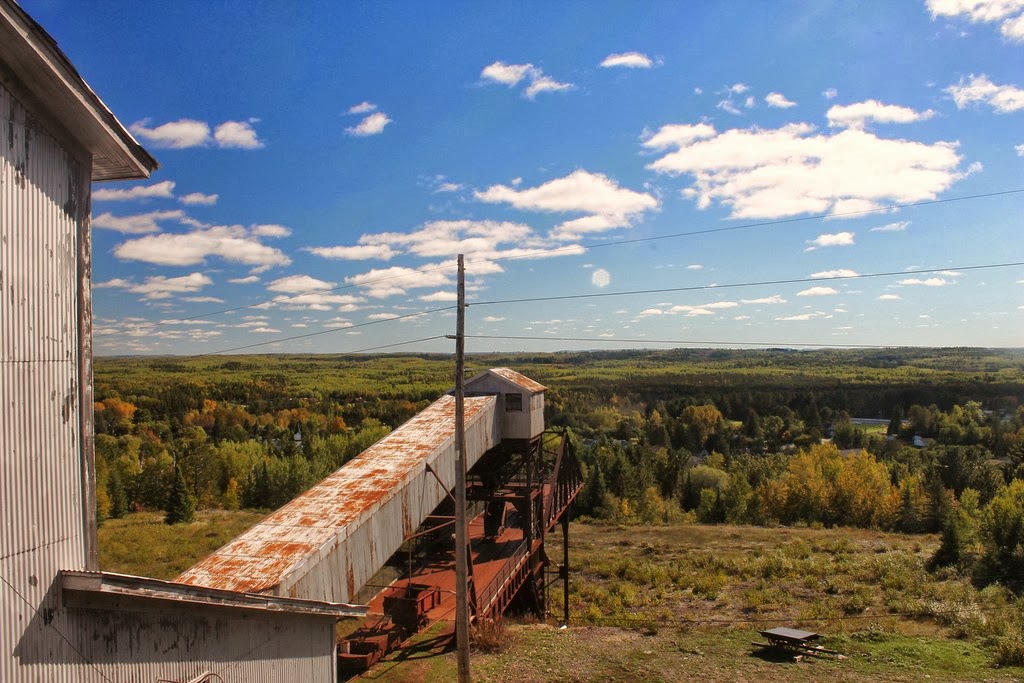I'm not sure WHAT it is with us and mines. We also went to a mine last summer during our Keeweenah trip, and we had a great time in both. I guess we're just nosy people - we like historical sites and old machinery and museums and seeing how things work. Joe got to tour an eyeglass lens factory a few weeks ago and I was SO JEALOUS. So I was super excited to go to Soudan Underground Mine State Park, on the south shore of Lake Vermilion.
Anyway, the Soudan Underground Mine is the oldest and deepest iron ore mine in Minnesota. It started as an open pit mine in the late 1800's (you can still see remnants of the pits in the area) but moved underground around the turn of the century. They mined the hematite out of the ground until the 1960's, when the iron range went back to favoring open pit mines. Worse for the environment, but a lot cheaper than mining underground.
 |
| The headframe for the shaft that took miners down to their workplace...and tourists nowadays. |
Joe and I plopped down our $12.00 each for a tour and joined the rest of the group in the small theater. We watched a 10-minute movie about the history of the mine. My favorite part of the movie was listening to the old miners talk about their times in the mine. These guys had the thickest Minnesotan accents that this Minnesotan girl has ever heard. I remember reading that this sort of regional accent is dying out in the USA, due to mass media and global culture. I'm glad to report that the Minnesotan accent appears to be thriving on the iron range.
 |
| Under the Sea (level) Under the Sea (level) |
After being given our nifty miner hats, we were crammed into the elevators that the miners used. Small, dark, and noisy; we plummeted down 2,300 feet to Level 27. Level 27 was the last one mined before operations shut down. The ride was not exactly pleasant for me: too close, too noisy, too long of a trip. I don't think I would have been a very good miner.
Once we disembarked from the elevator, we boarded the small train that would take us through the tunnels to the large open area where the miners last worked. The train chugged along the track like an amusement park ride. We were told that the miners never had to walk to their workplace, it was too far. They took the train, just like we did.
 |
| All aboard the Big Thunder Mountain Railroad |
We saw just a few bats while we were on the mine tour. We have been debating whether or not to visit Forestville Mystery Cave State Park this year due to the discovery of White Nose Bat Syndrome in their bat population. White Nose Bat Syndrome will usually decimate the entire bat population of a cave in a single year. If we wait until next year to go to the park, it's likely there will be no bats left. It's getting late in the year so we probably won't get to Mystery Cave. That's a bummer. :-(
The bats that live in Soudan Underground Mine mainly live on levels 10 and 11 of the mine complex - not visited by the mine tourists. We were told that the few bats we saw on Level 27 were probably doomed - not by White Nose Bat Syndrome, but by somehow winding up so far underground. The bats we saw must have caught the elevator down to Level 27 (either inside or on top of it). There's nothing to eat down there, of course; and it is too far of a distance back to the outside for them to fly. The poor bats that wind up at the bottom of the mine will likely stay there forever.
 |
| Dwelt a miner, forty-niner, and his daughter Clementine |
I wish I had some better pictures of the inside of the mine...but do you know how hard it is to take pictures of a nearly dark cavern? The cavern was much larger than I thought it would be. I always imagine miners standing in narrow, low tunnels (like the one that the train went through, above); chipping away at the walls with chisels. No, these miners worked in a space the size of a ballroom and used dynamite. They mined the ceiling: the iron ore is really heavy (if you've held hematite, you know what I mean). The iron ore was dislodged with dynamite and separated by hand, then dumped into shafts into waiting carts on a lower level, to be taken back up the shafts to the processing areas aboveground. The waste material (shale, jasper, etc) was piled up to raise the floor of the cavern. In this way, the miners were able to keep going up and up: removing the iron ore and building the floor with the rest. Very cool idea - no waste wound up aboveground. Too bad it's ten times as expensive as open pit mining. :-/
 |
| Lifesize diorama of a miner poking at the ceiling to see if there's any loose rock after a dynamite blast. Not a job for wimps! |
In addition to the historical mine, there is also an underground physics laboratory at the Soudan Underground Mine. The University of Minnesota is conducting experiments into the existence and nature of Dark Matter just on the other side of this exciting Electricity sign. Nobody was home so we could not go on the physics lab tour that day. Maybe next time! I think it'd be really cool to see what sort of experiments can only be done when 2,300 feet below the surface of the earth.
All in all, it was totally cool and I highly recommend it to anybody who happens to be in the Ely/Lake Vermilion/Boundary Waters area. So long as you're not terribly claustrophobic, of course! The mine itself wasn't a problem, but I could live without the trip down on the elevator.


No comments:
Post a Comment